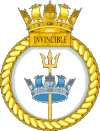HMS Invincible (R05)

HMS Invincible in 1990
|
|
| History | |
|---|---|
|
|
|
| Ordered: | 17 April 1973 |
| Builder: | Vickers Shipbuilding Limited, Barrow-in-Furness, England |
| Laid down: | July 1973 |
| Launched: | 3 May 1977 |
| Sponsored by: | Queen Elizabeth II |
| Commissioned: | 11 July 1980 |
| Decommissioned: | 3 August 2005 |
| Homeport: | HMNB Portsmouth |
| Identification: | |
| Nickname(s): | "Vince" |
| Fate: | Scrapped |
| Badge: |  |
| General characteristics | |
| Class and type: | Invincible-class aircraft carrier |
| Tonnage: | 16,000 tonnes (light) |
| Displacement: | 22,000 long tons (22,000 t) fully loaded |
| Length: | 689 ft (210 m) |
| Beam: | 118.1 ft (36.0 m) |
| Draught: | 28.9 ft (8.8 m) |
| Propulsion: |
|
| Speed: | 28 knots (52 km/h), 18 knots (33 km/h) cruising |
| Range: | 7,000 nautical miles at 18 knots (13,000 km at 33 km/h) |
| Complement: | 1,051 total, including 726 ship's company and 384 Air Group personnel |
| Armament: |
|
| Aircraft carried: |
|
HMS Invincible was the Royal Navy's lead ship of the three light aircraft carriers in her class. She was launched on 3 May 1977 as the seventh ship to carry the name. She saw action in the Falklands War when she was deployed with HMS Hermes and took over as flagship of the British fleet when Hermes was sold to India. Invincible was also deployed in the Yugoslav Wars and the Second Gulf War (Iraq War). In 2005, she was decommissioned and eventually sold for scrap to the Turkish company Leyal Ship Recycling in February 2011.
Invincible was built at Barrow-in-Furness by Vickers Shipbuilding and Engineering. She was laid down in 1973, launched on 3 May 1977 and commissioned on 11 July 1980, whereafter she joined the fleet's other carriers Hermes and Bulwark in service.
On 25 February 1982, after several months of negotiations, the Australian government announced that it had agreed to buy Invincible for £175 million as a replacement, under the name HMAS Australia, for the Royal Australian Navy's HMAS Melbourne. The sale was confirmed by the Ministry of Defence.
On 2 April 1982, however, Argentina invaded the Falkland Islands. Three days later, a naval task force headed by Invincible and Hermes left HMNB Portsmouth bound for the South Atlantic and, on 20 April, the British war cabinet ordered the repossession of the Islands. Along with eight Sea Harriers, the Invincible's airgroup included twelve Sea King helicopters that were slightly larger than the ship had originally been designed to accommodate. Small machine guns were added around the flight deck and island for close-in defence.
...
Wikipedia
